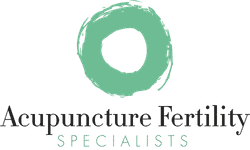To determine the role of electro stimulation acupuncture and traditional combined with auricular acupuncture on IVF outcomes in good prognosis patients.
Design
Retrospective case controlled clinical study. Acupuncture Consortium for treatment standardization. Reproductive EndocrinologysInfertility IVF Private Practice and Traditional Chinese Medicine Acupuncture Clinics.
Materials and methods
One hundred fourteen infertile patients undergoing controlled ovarian hyperstimulation with gonadotropins and GnRH agonist and antagonist for IVF-ET (2001 to 2003) in private practice IVF clinic. Only IVF patients with normal Day 3 FSH, normal uterine artery pulsatility indices, sperm morphologies over 7% normal by Kruger Strict Criteria and good response to ovarian hyperstimulation protocols (i.e., E2 over 2000 pg/ml) were analyzed.Intervention (s): Electrostimulation acupuncture — reduction of Pulsatility Index (PI) of the uterine artery and Traditional combined with Auricular acupuncture — Pre/Post embryo transfer protocols were used alone or in combination and resultant pregnancy outcomes were measured after IVF treatments. Main Outcome Measure(s): Cycles were grouped according to those that received No Acupuncture (Non-Ac) and those that received either one or both acupuncture treatments (Ac). Comparisons were made between Acupuncture treated IVF patients and Non − Acupuncture treated IVF patients in clinical pregnancies, ongoing pregnancies and birth outcomes. The statistics used for this analysis included; Tests for normal distribution: chi-square test, Kolmogorov-Smirnov Test Unpaired T-tests Stepwise Multiple regression Variance ratio test (F-Test) One-Way analysis of variance (ANOVA) with Student-Newman-Keuls (SNK) test for pair wise comparison of subgroups.
Results
Total IVF cases 114, 53 with Acupuncture (Ac) and 61 without Acupuncture (Non-Ac). Demographics, Infertility Diagnoses, and Treatment Protocols were statistically the same between both groups and by design, the following parameters were similar: Sperm Morphology; Peak Day 3 FSH; Average Pulsatility Index; Peak E2 at hCG; and Post hCG P4. These parameters earned the designation of Good Prognosis group. Pregnancy rates (PR) and Miscarriage rates (SAB) were statistically improved at the p < 0.05 levels in those patients that received Acupuncture (51% v 36% PR and 8% v 20% SAB in the AC v Non-Ac groups). There were no ectopic pregnancies in the Ac group and 9% in the Non-Ac group, p < 0.008. Finally, Birth rates (BR) per cycle start and per pregnancy were significantly higher in the Ac group, with 23% more births/pregnancy significant at the p < 0.05 level.
Conclusion
The use of adjunctive therapies in IVF protocols is gaining popularity. In previously published data, Acupuncture was reserved for Poorer Prognosis patients and enhanced outcomes were observed. In this study, we demonstrated that Good Prognosis patients would also benefit from inclusion of published Acupuncture protocols. This is also the first publication of Birth outcome data in Acupuncture treated IVF patients. Acupuncture significantly increased birth outcomes; it significantly decreased ectopic pregnancies and miscarriage rates. These data uniquely support a definitive role of both Electrostimulation and Traditional combined with Auricular Acupuncture in IVF in Good Prognosis IVF patients.
Reproductive Medicine & Fertility Center, Colorado Springs, CO; East Winds Acupuncture, Inc., Colorado Springs, CO
Supported by: None.
PII: S0015-0282(04)01505-5
doi:10.1016/j.fertnstert.2004.07.205
© 2004 Published by Elsevier Inc.
Influence of acupuncture on idiopathic male infertility in assisted reproductive technology.
Twenty patients with idiopathic male infertility (less than 20 million perm per ml., less than 20% rapidly motile sperm, less than 30% normal form sperm) who had all failed at least twice with ART, were treated with acupuncture twice weekly for eight weeks at Baihui DU-20, Neiguan P-6, Xuehai SP-10, Neiting ST-44, Shenshu BL-23, Sanyinjiao SP-6, Xuanzhong GB-39, Gongsun SP-4, Fenglong ST-40, Qihai REN-6 and Guanyuan REN-4. Thee months later they underwent ICSI. Rapid sperm motility after acupuncture was significantly improved and the normal form sperm ratio was increased after acupuncture. Fertilisation rates after acupuncture (66.2%) were obviously higher than that before treatment (40.2%, P < 0.01), with four pregnancies (18.2%). There was no significant difference in sperm concentration and general sperm motility after acupuncture. The embryo quality after acupuncture was improved, but the difference was not significant (P> 0.05).
Zhang M, Huang G, Lu F, Paulus WE, Sterzik K. (2002). J Huanzhong Univ Sci Technolog Med Sci. 22:3, 228-30.
Effect of acupuncture on sperm parameters of males suffering from subfertility related to low sperm quality
Semen samples of 16 acupuncture-treated subfertile patients were analysed before and one month after treatment (twice a week for five weeks). In parallel, semen samples of 16 control untreated subfertile males were examined. Two specimens were taken from the control group at an interval of 2-8 months. The expanded semen analysis included routine and ultramorphological observations.
The fertility index increased significantly (p < or = .05) following improvement in total functional sperm fraction, percentage of viability, total motile spermatozoa per ejaculate, and integrity of the axonema (p < or = .05), which occurred upon treatment. The intactness of axonema and sperm motility were highly correlated (corr. = .50, p < or = .05). Thus, patients exhibiting a low fertility potential due to reduced sperm activity may benefit from acupuncture treatment.
Siterman S, Eltes F, Wolfson V, Zabludovsky N, Bartoov B. (1997).
Arch Androl. 39:2, 155-61.

